Neuroscience Notes - Neuronal excitability
Notes taken form Neuroscience course, Part 2: Neuronal excitability.
Last update: Oct. 21, 2020

Translation of Terms
| Eng | Chs | Comment |
|---|---|---|
| dendrite | 树突 | |
| axon | 轴突 | |
| synapse | 突触 | |
| myelin sheath | 髓鞘 | |
| vagus nerve | 迷走神经 | |
| ionotropic | ||
| exocytosis | 胞外分泌 | |
| vesicle | 泡,囊 | |
| ionotropic | 离子移变的 | |
| acetylcholine | 乙酰胆碱 | ACh |
| hippocampus | 海马体 | info -> mem |
| spinal cord | 脊髓 |
Potentials
Membrane Potential
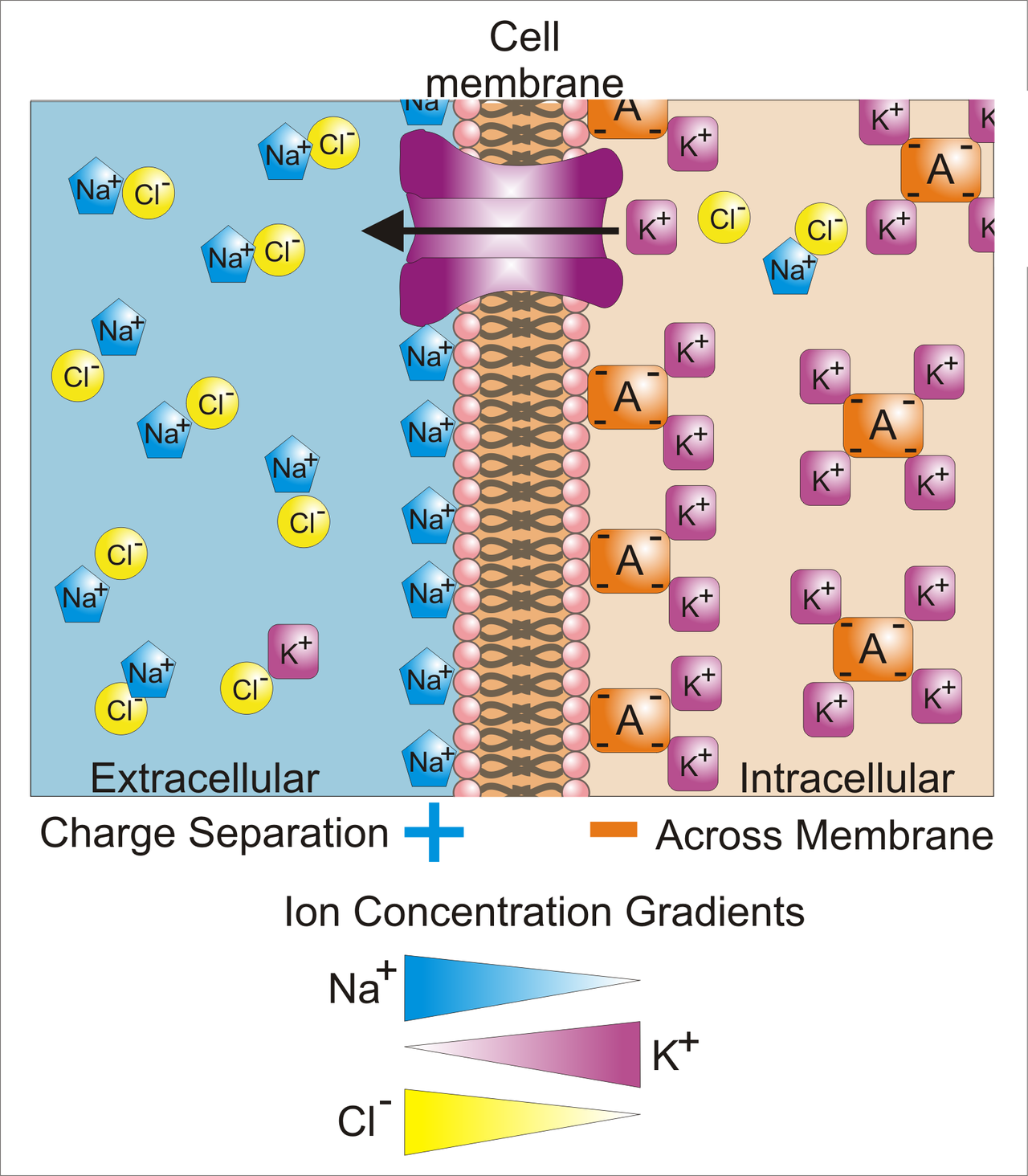
- ion pump: brings $K^+$ in and pushes ${Na}^+$ out.
Two forces on ions:
- Diffusion high -> low concentration $E_d = RTln([K^+]_o/[K^+]_i)$
- Coulomb: opposites attract; like charges repel $E_c = V_zF$
- For $K^+$, At equilibrium: $E_c = E_d$
But different ion channels cause different permeabilities for each ion. Therefore we need to times the permeability as weight to each ion when calculating the membrane potential.
- Depolarization: a change within a cell, during which the cell undergoes a shift in electric charge distribution, resulting in less negative charge inside the cell.
- Hyperpolarization: a change in a cell’s membrane potential that makes it more negative.
i-on channel
- ${Na}^+$ channel: voltage gated (neg potential -> closed gate)
- Depolarization: positive feedback of ${Na}^+$ channel
- Membrane depolarization
- increase in $g_{Na^+}$
- more ${Na}^+$ rushes into cell
- lead to 1 => positive feedback
However, $K^+$ behave differently => No feedback
Electrophysiology
- Current: $I =\Delta Q/\Delta t$
- Ohm’s law
- Abstract neuron as circuit: pumps(voltage src) - switch // resistor // capacitor
Hodgkin & Huxley
Energy Barrier Model
- Gate: voltage dependence, time dependent
- 双向流动的模型:$dy/dt = \alpha(1-y)-\beta y$ => $y_{\infty} = \alpha/(\alpha + \beta)$
β
open(y) ⇋ closed(1-y) => y∞ (steady state)
α
Hodgkin and Huxley’s Model
ref: wiki_HHModel
- Experiment on squid giant axon with voltage clamp
- a brief inward current followed by a longer outward current
- TTX blocking $Na^+$ channels and TEA blocking $K^+$ channels => separate the current of each type of channels

Synaptic Transmission
- Electrical synapses
- Chemical synapses
Otto Loewi’s Experiments
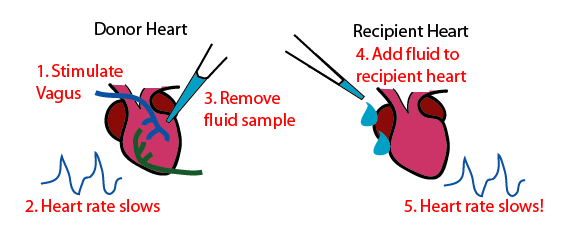
- Two hearts
- stimulate one’s vagus nerve
- transfer the solution to heart 2
- both of these two heart rates slows
Bernard Katz’s Experiments
mEPP: miniature end plate potential
- Action potential needs to reach the threshold (EPP)
- mEPPs are spontaneous
- EPPs are evoked!
- => quantal hypothesis: probability; quantum; evoked EPP by several quanta
Quantal Analysis
- number of packets released $m = V_{EPP}/V_{mEPP}$
- release of quanta: follow a Poisson distribution: $P(x) = m^xe^{-m}/x!$
- => counting the times evoked EPPs deliver no transmitter => P(0) => m
- => vesicles were the transmitter quanta
Chemical Synaptic Transmission
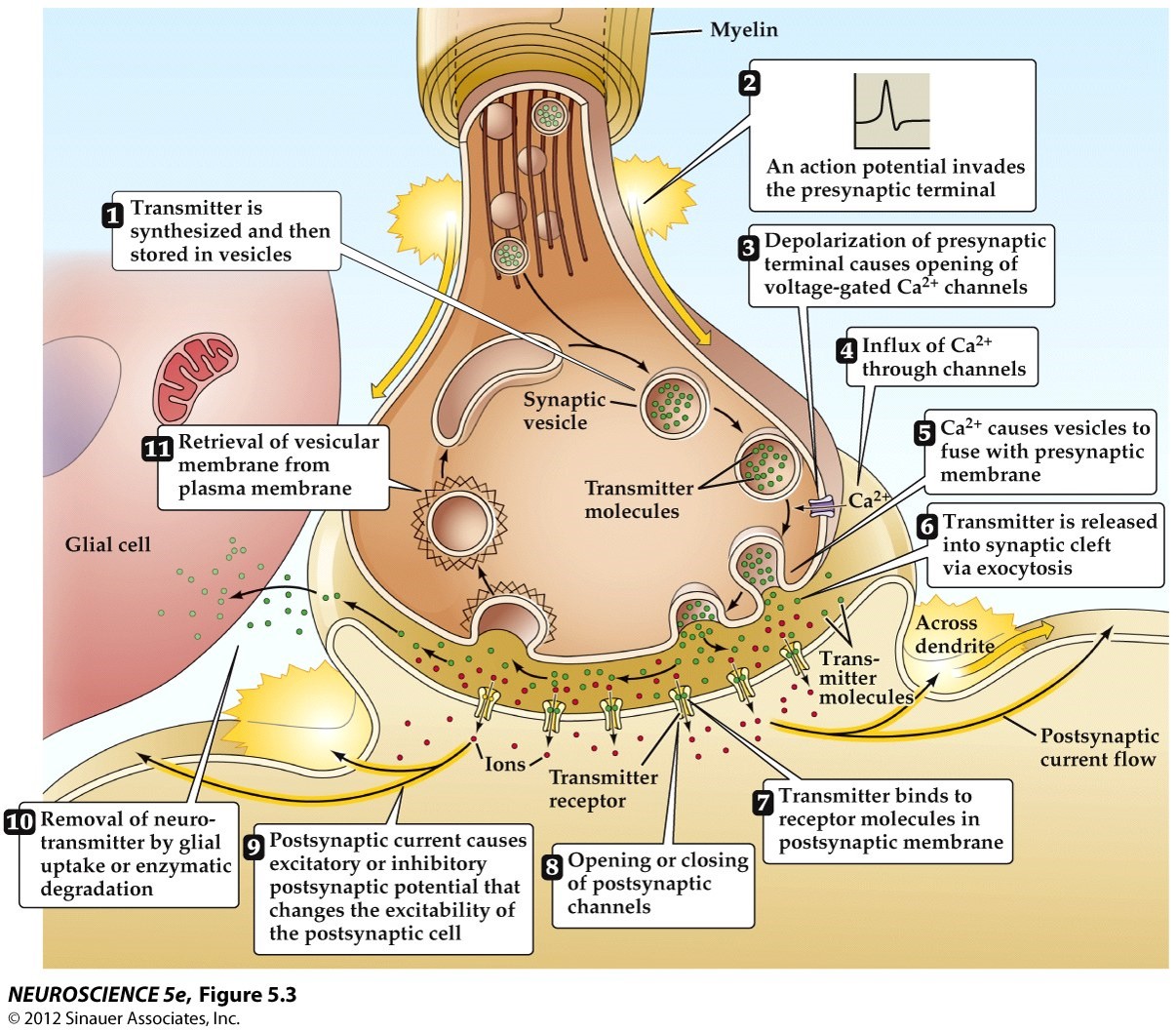
- $Na^+$ in, $K^+$ out => Synapse
- voltage-gated channels open => $Ca^{++}$ in
- vesicles to fuse with membrane => release transmitter that diffuse across the synaptic cleft
- transmitter molecules reach receptors (postsynaptic) => open channels and letting in ions
- synaptic vesicles in presynaptic terminals can be recycled
Two Categories:
- Ionotropic: fast, local channel-mediated changes in membrane potential (EPSPs, IPSPs)
- Metabotropic: slow, G-protein- and second-messenger- mediated changes
Benifits of chemical transmission
- Graded vs. all-or-none: analog vs. digital
- Amplification
- Sign inversion
- Varied temporal duration
- Multiple receptors with distinct properties
- Malleability/plasticity
Synaptic Reversal Potentials
- EPC: end plate current, the macroscopic current resulting from the summed opening of many ion channels
-
reversal potential: the membrane potential at which a given neurotransmitter causes no net current flow of ions through that neurotransmitter receptor’s ion channel.
- $Ca^{2+}$ entry through the specific voltage-dependent calcium channels in the presynaptic terminals causes transmitter release
- a rise in presynaptic Ca2+ concentration triggers transmitter release from presynaptic terminals
Gap Junctions

- Electrical Synapse
Synaptic plasticity

Short-term
- May conduct synaptic computation
- May serve as a frequency filter
Facilitation
The 2nd pulse is larger. => the amount = $A2/A1$
- Synapse has a low initial probability of transmitting.
- Later pulses, letting in more $Ca^{++}$, allow vesicles to move forward => second pulse larger
Depression
just opposite case of facilitation
Model
- Amplitude $A = A_0FD$
- Facilitation para: $F \rightarrow F+f$
- Depression para: $D \rightarrow Dd$
- Facilitation decay: $\tau_F\frac{dF}{dt} = 1-F$
- Depression decay: $\tau_D\frac{dD}{dt} = 1-D$
Long-term
psychology <–> physiology
association <–> synapse
Origin
- Aristotle
- William James
- Donald Hebb
Hippocampus and H.M.
- Surgery to prevent continued epileptic seizures
- Both hippocampi removed
- Unable to learn new “declarative” information
- Could learn new motor skills: golf, mirror writing
The discovery of long-term potentiation
synapses can experience long-lasting changes
Associative and Hebbian LTP
Association
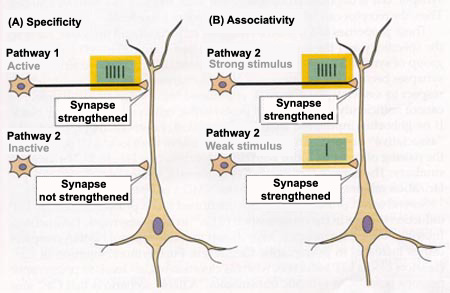

Apply HF input on both weak and strong pathways can cause long-term potentiation => they are associated
Hebbian
Apply input and depolarize the neuron at the same time can have similar effect.
Spike-timing-dependent plasticity (STDP)
- LTP can be temporally very precise: timing sensitive
- causes earlier firing: rehearsal of a thing can be “adapted”
- competition: fire early -> stronger -> fire earlier; fire late -> weaker -> fire later
Induction and expression
- NMDA receptor
Long-term depression
Low frequency input will cause long-term depression in EPSP. This may support “forgetting” mechanism in memory
Intrinsic Properties
- Regular spiking cell
- Intrinsically bursting cell
- Fast spiking cell
Cortical neuron firing patterns

Diverse ion currents
$Na^+$ currents
- $I_{Na,t}$: transient, rapidly activating & inactivating => action potentials
- $I_{Na,p}$: persistent, noninactivating => enhances depolarization; steady-state firing
$Ca^{2+}$ currents
- $I_T$(low thresh): transient; -65 mV thresh => rhythmic burst firing
- $I_L$(high thresh): long-lasting, -20 mV thresh => $Ca^{2+}$ spikes that are prominent in dendrites; synaptic transmission
- $I_N$: neither; rapidly inactivating, thresh -20 mV => same as $I_L$
$K^+$ currents
- $I_K$: activated by strong depolarizataion => repolarization of action potential
- $I_C$: activated by $[Ca^{2+}] \uparrow$ => action potential repolarization & interspike interval
- $I_h$: depolarizing current, activated by hyperpolarization => rhythmic burst firing
A simple model

Thalamic neurons and rhythms
- Two different patterns: oscillatory(bursting) tonic(transfer) modes
Intrinsic Plasticity
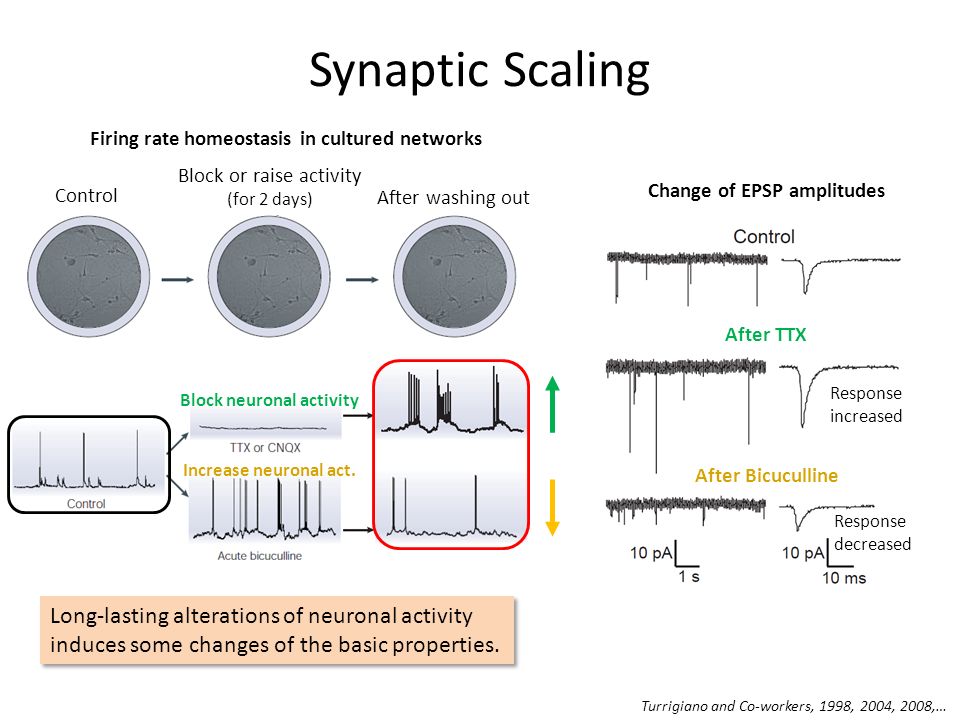
It seems perhaps all currents can be up- or down-regulated depending on experience.
Network Memory: Memory and Encoding
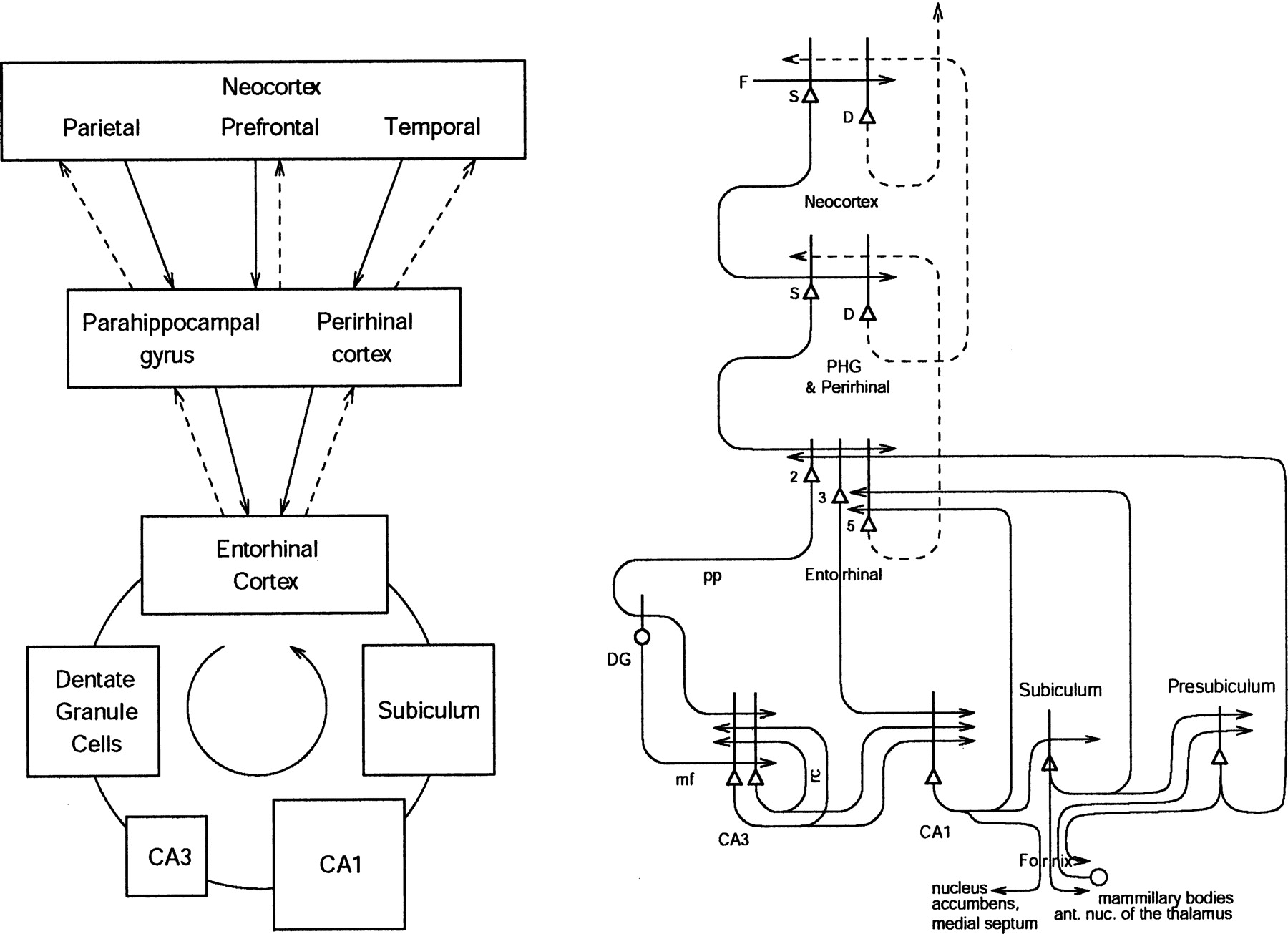
- Autoassociative sub-network (CA3) => pattern completion
- Heteroassociative sub-network (CA1, DG) => link different complex patterns
- Too many memories => degradation
Hebbian Rule (Hebbian theory)
Let us assume that the persistence or repetition of a reverberatory activity (or “trace”) tends to induce lasting cellular changes that add to its stability. … When an axon of cell A is near enough to excite a cell B and repeatedly or persistently takes part in firing it, some growth process or metabolic change takes place in one or both cells such that A’s efficiency, as one of the cells firing B, is increased.
It’s just like training and testing a neural network.
Lattice Rules
Borrow the theory from ferromagnetism and lowest energy theory to explain the phenomenon in memory network.
- Annealing: Ordered -heat-> Disordered -cool-> Ordered
- Alternating Spins: the relationship with an atom from neighbor to distant ones are alternatively opposite and same spins.
- Calculate energy: harmonious (-1), frustrated (+1)
Basic Rules
Two atoms can have:
- no relationship
- same spins
- opposite spins
Energy Surface
- we can calculate the energy of this system, by sum up the energy of each pair of atoms
- system moves toward lower energy
- low energy states are “attractors”
Experiment: False memory
Emergent Properties
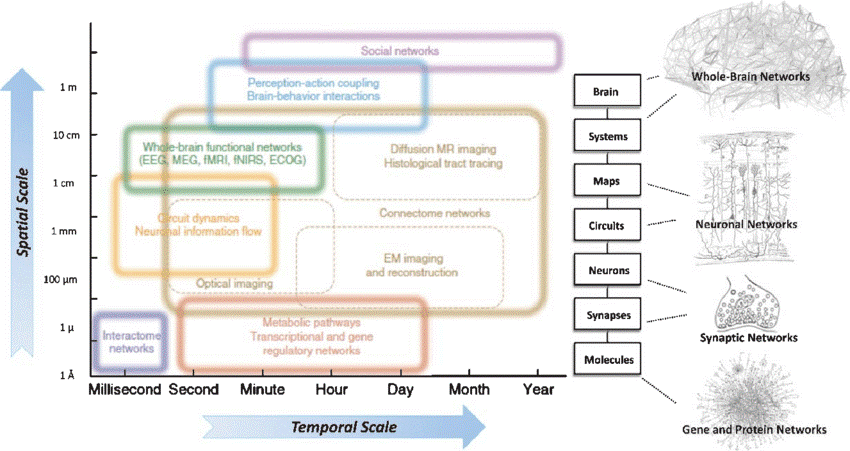
Reductionism
Low level —> High level
- the molecular basis of Huntington’s disease
- brain rhythms and criticality as examples of emergent properties
- Language: FOXP2 is considered as language gene
Emergentism
High level —> Low level
Criticality
| Low Temp | Critical Temp | High Temp |
| Ordered | Complex | Random |
Correlations
$C_{ij} = (i - )(j-
- Great corr length
- Critical point is optimal


留下评论